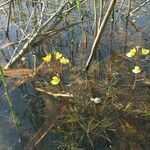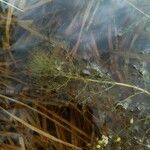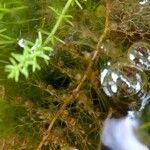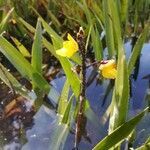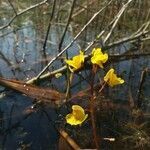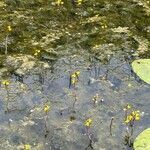Perennials, suspended aquatic. Rhizoids usually present, filiform, with dichotomously divided branches. Stolons filiform, branched. Traps on leaf segments, stalked, ovoid, 1.5-5 mm, mouth lateral; appendages 2, dorsal, simple or branched, setiform, with shorter simple lateral setae. Leaves numerous on stolons, 1.5-6 cm, divided from base into 2 unequal primary segments; primary segments ovate, elliptic, or ovate-oblong in outline, pinnately divided into secondary segments; secondary segments dichotomously divided into many further segments; ultimate segments capillary, slightly flattened, apically and laterally minutely setulose, without or sometimes with short marginal teeth. Inflorescences erect, 10-30 cm, 3-12-flowered, glabrous; peduncle terete, 1-2.4 mm thick; scales 1-4, similar to bracts; bracts basifixed, broadly ovate, 3-7 mm, base cordate to auriculate, apex acute to obtuse. Pedicel erect at anthesis but decurved in fruit, terete, 0.6-1.5 cm; bracteoles absent. Calyx lobes ovate, 2.5-5 mm, glandular; lower lobe slightly shorter than upper lobe, apex obtuse to emarginate; upper lobe apex acute to subacute. Corolla yellow, 1.2-2 cm; lower lip transversely elliptic to broadly ovate, base with prominent swelling, margin strongly deflexed, apex retuse; spur narrowly conic to narrowly cylindric from a conic base, shorter than or ± as long as corolla lower lip, straight or curved upward, apex slightly obtuse; palate distal 1/2 covered with short hairs and stipitate glands; upper lip broadly ovate, ca. 2 × as long as upper calyx lobe, apex retuse to truncate. Filaments ca. 2 mm, curved; anther thecae ± distinct. Ovary globose, densely glandular; style evident; stigma lower lip suborbicular and ciliate, upper lip truncate to broadly deltoid. Capsule globose, ca. 5 mm in diam., circumscissile. Seeds prismatic, 0.3-0.4 × 0.5-0.7 mm, 4-6-angled, narrowly winged on all angles; seed coat with small prominent slightly elongate reticulations. Fl. Jun-Aug, fr. Jul-Sep.
More
Submersed, free-floating; lvs numerous, 1–5 cm, mostly 2-parted at base and then repeatedly and unequally (quasipinnately) dichotomous, the segments terete, progressively narrower, the ultimate ones filiform and strongly acuminate; bladders numerous, on the lvs; peduncles emergent, 6–20 cm, with 1–several scattered bracts below the infl; fls mostly 6–20 in a lax raceme, yellow, the lower lip mostly about equaling the upper, slightly lobed, 1–2 cm, with well developed palate; spur falcate, directed forward, two-thirds as long as the lower lip; pedicels arcuate-recurved in fr; 2n=44. Quiet water; circumboreal, s. to Fla. and Calif. June–Aug. (U. macrorhiza)
A herb. It keeps growing from year to year suspended in water. It has underwater stems which are narrow and divided. It has very thin stolons or runners. The bladders are 0.5 cm across and amongst the leaves. The leaves are narrowly oval and 3-5 cm long by 2-6 mm wide. The flowers are rich golden yellow. They are in groups of 6-8 on long stems above the water.
